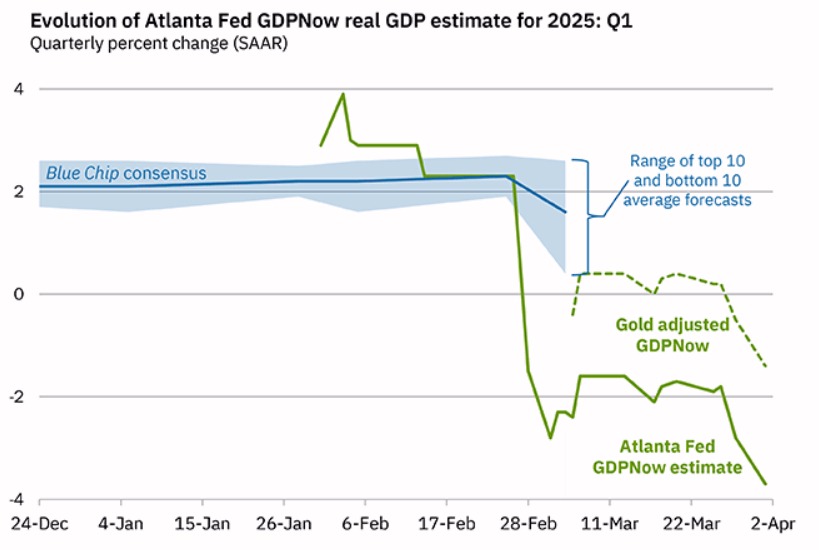by Daniel Brouse
April 1, 2025
The Atlanta Fed’s GDPNow model estimate for real GDP growth (seasonally adjusted annual rate) in the first quarter of 2025 has been revised downward to -3.7% as of April 1, a significant drop from the previous estimate of -2.8% on March 28. This sharp decline reflects increasing signs of economic weakness, with downward adjustments driven by recent economic data releases.
The latest revision follows the release of the U.S. Census Bureau’s construction spending report and updated March data, which have been incorporated into the models’ dynamic factor model. This includes key economic indicators such as manufacturing data from the Institute for Supply Management (ISM) and consumer sentiment measures from two major surveys. As a result, projections for real final sales to private domestic purchasers—a measure that excludes inventory changes and trade to focus on underlying domestic demand—have also been downgraded significantly, from an already modest 1.5% growth to just 0.4%.
This decline in final sales growth suggests weakening consumer and business demand, a concerning sign for the broader economy. The steep drop in the GDPNow estimate highlights mounting economic headwinds, including potential slowdowns in construction activity, weaker manufacturing output, and dampened consumer confidence. The rapid downward adjustments underscore the fragile nature of the economy and raise the likelihood of a deeper economic contraction in the first quarter of 2025.
The Atlanta Fed’s GDPNow tracker is unique among economic forecasting models because it relies entirely on real-time economic data rather than subjective adjustments, expert judgments, or historical trend corrections. This distinguishes it from models used by institutions like Goldman Sachs, the Congressional Budget Office (CBO), or the Federal Reserve Board, which incorporate analyst assumptions and long-term economic trends into their projections.
Key Features of GDPNow’s Real-Time Approach
-
Data-Driven, No Human Adjustments
-
GDPNow updates its estimates immediately as new economic reports are released.
-
Unlike other forecasts, it does not incorporate expert opinions, policy expectations, or qualitative analysis.
-
-
Incorporation of Official Economic Indicators
-
The model dynamically integrates data from government reports and key economic surveys, such as:
-
Retail Sales & Personal Consumption (from Census Bureau & BEA)
-
Industrial Production & Manufacturing Data (from the Federal Reserve & ISM)
-
Housing Market & Construction Spending (from the Census Bureau)
-
Trade Balance & Net Exports (from the Bureau of Economic Analysis)
-
-
As soon as this data is released, GDPNow automatically recalculates GDP growth rather than relying on outdated estimates.
-
-
No Lag in Economic Signal Processing
-
Traditional economic models smooth out extreme movements by adjusting for historical trends or potential policy impacts.
-
GDPNow, however, reflects economic conditions as they happen, allowing for a faster reaction to economic shocks (e.g., sudden supply chain disruptions, inflation surges, or unexpected recessions).
-
-
Comparisons to Traditional Forecasts
-
Goldman Sachs, Morgan Stanley, and Federal Reserve models include human judgment, adjustments for policy changes, and expectations about long-term economic behavior.
-
These models might underestimate sudden downturns because they assume mean reversion (the idea that GDP will return to its trend level).
-
GDPNow has historically provided more accurate short-term predictions during periods of economic volatility.
-
Why This Matters
Because GDPNow operates solely on real-time data, it is often the first indicator of economic slowdowns or recessions before other forecasters adjust their outlooks. The recent sharp drop in the Q1 2025 estimate to -3.7% (as of April 1) highlights its ability to reflect immediate economic deterioration rather than lagging behind consensus forecasts.
